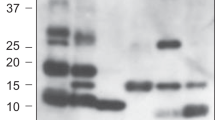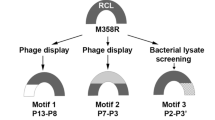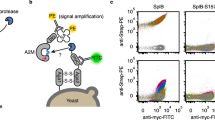Abstract
The specific inhibition of serine proteases, which are crucial switches in many physiologically important processes, is of value both for basic research and for therapeutic applications. Ecotin, a potent macromolecular inhibitor of serine proteases of the S1A family, presents an attractive scaffold to engineer specific protease inhibitors because of its large inhibitor-protease interface. Using synthetic shuffling in combination with a restricted tetranomial diversity, we created ecotin libraries that are mutated at all 20 amino acid residues in the binding interface. The efficacy of these libraries was demonstrated against the serine protease plasma kallikrein (Pkal). Competitive phage display selection yielded a Pkal inhibitor with an apparent dissociation equilibrium constant (Ki*) of 11 pM, whereas Ki* values for related proteases (such as Factor Xa (FXa), Factor XIa (FXIa), urokinase-type plasminogen activator (uPA), thrombin, and membrane-type serine protease 1 (MT-SP1)) were four to seven orders of magnitude higher. The adaptability of the scaffold was demonstrated by the isolation of inhibitors to two additional serine proteases, MT-SP1/matriptase and Factor XIIa.
This is a preview of subscription content, access via your institution
Access options
Subscribe to this journal
Receive 12 print issues and online access
$209.00 per year
only $17.42 per issue
Buy this article
- Purchase on Springer Link
- Instant access to full article PDF
Prices may be subject to local taxes which are calculated during checkout




Similar content being viewed by others
References
Rawlings, N.D. Introduction: family S1 of trypsin. in Handbook of Proteolytic Enzymes (eds. Barrett, A.J., Rawlings, N.D. & Woessner, J.F.) 5–12 (Academic Press, London, UK, 1998).
Rawlings, N.D., O'Brien, E.A. & Barrett, A.J. MEROPS: the protease database. Nucleic Acids Res. 30, 343–346 (2002).
Bhatt, A.S. et al. Quantification of membrane type serine protease 1 (MT-SP1) in transformed and normal cells. Biol. Chem. 384, 257–266 (2003).
Hooper, J.D., Clements, J.A., Quigley, J.P. & Antalis, T.M. Type II transmembrane serine proteases. Insights into an emerging class of cell surface proteolytic enzymes. J. Biol. Chem. 276, 857–860 (2001).
Yousef, G.M. & Diamandis, E.P. Human tissue kallikreins: a new enzymatic cascade pathway? Biol. Chem. 383, 1045–1057 (2002).
Takeuchi, T., Shuman, M.A. & Craik, C.S. Reverse biochemistry: use of macromolecular protease inhibitors to dissect complex biological processes and identify a membrane-type serine protease in epithelial cancer and normal tissue. Proc. Natl. Acad. Sci. USA 96, 11054–11061 (1999).
Lin, C.Y., Anders, J., Johnson, M., Sang, Q.A. & Dickson, R.B. Molecular cloning of cDNA for matriptase, a matrix-degrading serine protease with trypsin-like activity. J. Biol. Chem. 274, 18231–18236 (1999).
Kim, M.G. et al. Cloning and chromosomal mapping of a gene isolated from thymic stromal cells encoding a new mouse type II membrane serine protease, epithin, containing four LDL receptor modules and two CUB domains. Immunogenetics 49, 420–428 (1999).
Oberst, M.D. et al. Expression of the serine protease matriptase and its inhibitor HAI-1 in epithelial ovarian cancer: correlation with clinical outcome and tumor clinicopathological parameters. Clin. Cancer Res. 8, 1101–1107 (2002).
Kang, J.Y. et al. Tissue microarray analysis of hepatocyte growth factor/Met pathway components reveals a role for Met, matriptase, and hepatocyte growth factor activator inhibitor 1 in the progression of node-negative breast cancer. Cancer Res. 63, 1101–1105 (2003).
Dhanasekaran, S.M. et al. Delineation of prognostic biomarkers in prostate cancer. Nature 412, 822–826 (2001).
Catalona, W.J. et al. Measurement of prostate-specific antigen in serum as a screening test for prostate cancer. N. Engl. J. Med. 324, 1156–1161 (1991).
Hoffman, B.R. et al. Immunofluorometric quantitation and histochemical localisation of kallikrein 6 protein in ovarian cancer tissue: a new independent unfavourable prognostic biomarker. Br. J. Cancer 87, 763–771 (2002).
List, K. et al. Matriptase/MT-SP1 is required for postnatal survival, epidermal barrier function, hair follicle development, and thymic homeostasis. Oncogene 21, 3765–3779 (2002).
Ebnet, K. et al. Granzyme A-deficient mice retain potent cell-mediated cytotoxicity. EMBO J. 14, 4230–4239 (1995).
Sanderson, P.E. Small, noncovalent serine protease inhibitors. Med. Res. Rev. 19, 179–197 (1999).
Leung, D., Abbenante, G. & Fairlie, D.P. Protease inhibitors: current status and future prospects. J. Med. Chem. 43, 305–341 (2000).
Perona, J.J., Tsu, C.A., Craik, C.S. & Fletterick, R.J. Crystal structures of rat anionic trypsin complexed with the protein inhibitors APPI and BPTI. J. Mol. Biol. 230, 919–933 (1993).
Chung, C.H., Ives, H.E., Almeda, S. & Goldberg, A.L. Purification from Escherichia coli of a periplasmic protein that is a potent inhibitor of pancreatic proteases. J. Biol. Chem. 258, 11032–11038 (1983).
Gillmor, S.A., Takeuchi, T., Yang, S.Q., Craik, C.S. & Fletterick, R.J. Compromise and accommodation in ecotin, a dimeric macromolecular inhibitor of serine proteases. J. Mol. Biol. 299, 993–1003 (2000).
McGrath, M.E., Erpel, T., Bystroff, C. & Fletterick, R.J. Macromolecular chelation as an improved mechanism of protease inhibition: structure of the ecotin-trypsin complex. EMBO J. 13, 1502–1507 (1994).
Wang, S.X., Esmon, C.T. & Fletterick, R.J. Crystal structure of thrombin-ecotin reveals conformational changes and extended interactions. Biochemistry 40, 10038–10046 (2001).
Eggers, C.T., Wang, S.X., Fletterick, R.J. & Craik, C.S. The role of ecotin dimerization in protease inhibition. J. Mol. Biol. 308, 975–991 (2001).
Seymour, J.L. et al. Ecotin is a potent anticoagulant and reversible tight-binding inhibitor of Factor Xa. Biochemistry 33, 3949–3958 (1994).
Ulmer, J.S., Lindquist, R.N., Dennis, M.S. & Lazarus, R.A. Ecotin is a potent inhibitor of the contact system proteases Factor XIIa and plasma kallikrein. FEBS Lett. 365, 159–163 (1995).
Colman, R.W. & Schmaier, A.H. Contact system: a vascular biology modulator with anticoagulant, profibrinolytic, antiadhesive, and proinflammatory attributes. Blood 90, 3819–3843 (1997).
Selvarajan, S., Lund, L.R., Takeuchi, T., Craik, C.S. & Werb, Z. A plasma kallikrein–dependent plasminogen cascade required for adipocyte differentiation. Nat. Cell Biol. 3, 267–275 (2001).
Dela Cadena, R.A. et al. Inhibition of plasma kallikrein prevents peptidoglycan-induced arthritis in the Lewis rat. FASEB J. 9, 446–452 (1995).
Stadnicki, A. et al. Specific inhibition of plasma kallikrein modulates chronic granulomatous intestinal and systemic inflammation in genetically susceptible rats. FASEB J. 12, 325–333 (1998).
Dennis, M.S., Herzka, A. & Lazarus, R.A. Potent and selective Kunitz domain inhibitors of plasma kallikrein designed by phage display. J. Biol. Chem. 270, 25411–25417 (1995).
Markland, W., Ley, A.C. & Ladner, R.C. Iterative optimization of high-affinity protease inhibitors using phage display. 2. Plasma kallikrein and thrombin. Biochemistry 35, 8058–8067 (1996).
Stemmer, W.P. Rapid evolution of a protein in vitro by DNA shuffling. Nature 370, 389–391 (1994).
Ness, J.E. et al. Synthetic shuffling expands functional protein diversity by allowing amino acids to recombine independently. Nat. Biotechnol. 20, 1251–1255 (2002).
Bogan, A.A. & Thorn, K.S. Anatomy of hot spots in protein interfaces. J. Mol. Biol. 280, 1–9 (1998).
Yang, S.Q. & Craik, C.S. Engineering bidentate macromolecular inhibitors for trypsin and urokinase-type plasminogen activator. J. Mol. Biol. 279, 1001–1011 (1998).
Laboissiere, M.C. et al. Computer-assisted mutagenesis of ecotin to engineer its secondary binding site for urokinase inhibition. J. Biol. Chem. 277, 26623–26631 (2002).
McBride, J.D., Freeman, N., Domingo, G.J. & Leatherbarrow, R.J. Selection of chymotrypsin inhibitors from a conformationally-constrained combinatorial peptide library. J. Mol. Biol. 259, 819–827 (1996).
Dennis M.S. & Lazarus R.A. Kunitz domain inhibitors of tissue factor-Factor VIIa. I. Potent inhibitors selected from libraries by phage display. J. Biol. Chem. 269, 22129–22136 (1994).
Yang, S.Q., Wang, C.I., Gillmor, S.A., Fletterick, R.J. & Craik, C.S. Ecotin: a serine protease inhibitor with two distinct and interacting binding sites. J. Mol. Biol. 279, 945–957 (1998).
Hecker, K.H. & Rill, R.L. Error analysis of chemically synthesized polynucleotides. Biotechniques 24, 256–260 (1998).
Chung, D.W., Fujikawa, K., McMullen, B.A. & Davie, E.W. Human plasma prekallikrein, a zymogen to a serine protease that contains four tandem repeats. Biochemistry 25, 2410–2417 (1986).
OASIS investigators. Effects of recombinant hirudin (lepirudin) compared with heparin on death, myocardial infarction, refractory angina, and revascularisation procedures in patients with acute myocardial ischaemia without ST elevation: a randomised trial. Lancet 353, 429–438 (1999).
Cappello, M., Vlasuk, G.P., Bergum, P.W., Huang, S. & Hotez, P.J. Ancylostoma caninum anticoagulant peptide: a hookworm-derived inhibitor of human coagulation Factor Xa. Proc. Natl. Acad. Sci. USA 92, 6152–6156 (1995).
Laroche, Y. et al. Recombinant staphylokinase variants with reduced antigenicity due to elimination of B-lymphocyte epitopes. Blood 96, 1425–1432 (2000).
Barbas, C.F., Kang, A.S., Lerner, R.A. & Benkovic, S.J. Assembly of combinatorial antibody libraries on phage surfaces: the gene III site. Proc. Natl. Acad. Sci. USA 88, 7978–7982 (1991).
Stoop, A.A., Jespers, L., Lasters, I., Eldering, E. & Pannekoek, H. High-density mutagenesis by combined DNA shuffling and phage display to assign essential amino acid residues in protein-protein interactions: application to study structure-function of plasminogen activation inhibitor 1 (PAI-I). J. Mol. Biol. 301, 1135–1147 (2000).
Morrison, J.F. Kinetics of the reversible inhibition of enzyme-catalysed reactions by tight-binding inhibitors. Biochim. Biophys. Acta 185, 269–286 (1969).
Kraulis, P.J. MolScript: a program to produce both detailed and schematic plots of protein structures. J. Appl. Crystallogr. 24, 946–950 (1991).
Fujikawa, K., Chung, D.W., Hendrickson, L.E. & Davie, E.W. Amino acid sequence of human Factor XI, a blood coagulation factor with four tandem repeats that are highly homologous with plasma prekallikrein. Biochemistry 25, 2417–2424 (1986).
Acknowledgements
We would like to thank C. Eggers for many helpful discussions regarding the data and the manuscript. This work was supported by a TALENT-stipend from the Netherlands Organization for Scientific Research to A.A.S. and grant CA72006 from the National Institutes of Health to C.S.C.
Author information
Authors and Affiliations
Corresponding author
Ethics declarations
Competing interests
The authors declare no competing financial interests.
Supplementary information
Rights and permissions
About this article
Cite this article
Stoop, A., Craik, C. Engineering of a macromolecular scaffold to develop specific protease inhibitors. Nat Biotechnol 21, 1063–1068 (2003). https://doi.org/10.1038/nbt860
Received:
Accepted:
Published:
Issue Date:
DOI: https://doi.org/10.1038/nbt860
This article is cited by
-
A protein scaffold, engineered SPINK2, for generation of inhibitors with high affinity and specificity against target proteases
Scientific Reports (2019)
-
Specifically targeting cancer proliferation and metastasis processes: the development of matriptase inhibitors
Cancer and Metastasis Reviews (2019)
-
Cell surface–anchored serine proteases in cancer progression and metastasis
Cancer and Metastasis Reviews (2019)
-
Protein fusion tags for efficient expression and purification of recombinant proteins in the periplasmic space of E. coli
3 Biotech (2016)
-
The pharmacological landscape and therapeutic potential of serine hydrolases
Nature Reviews Drug Discovery (2012)



